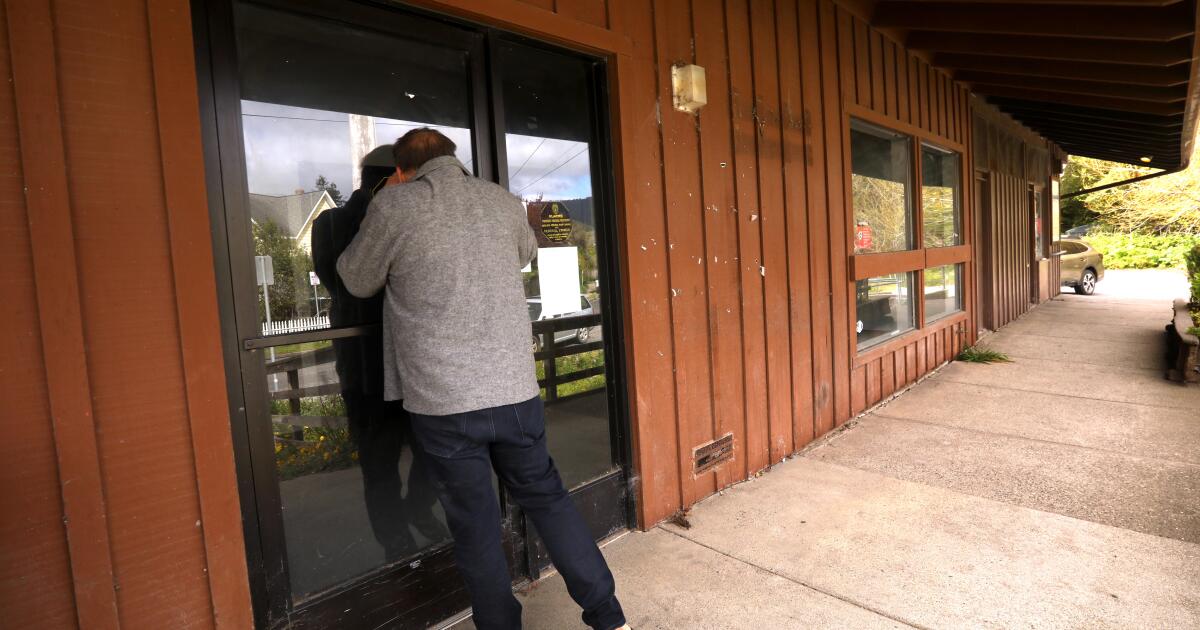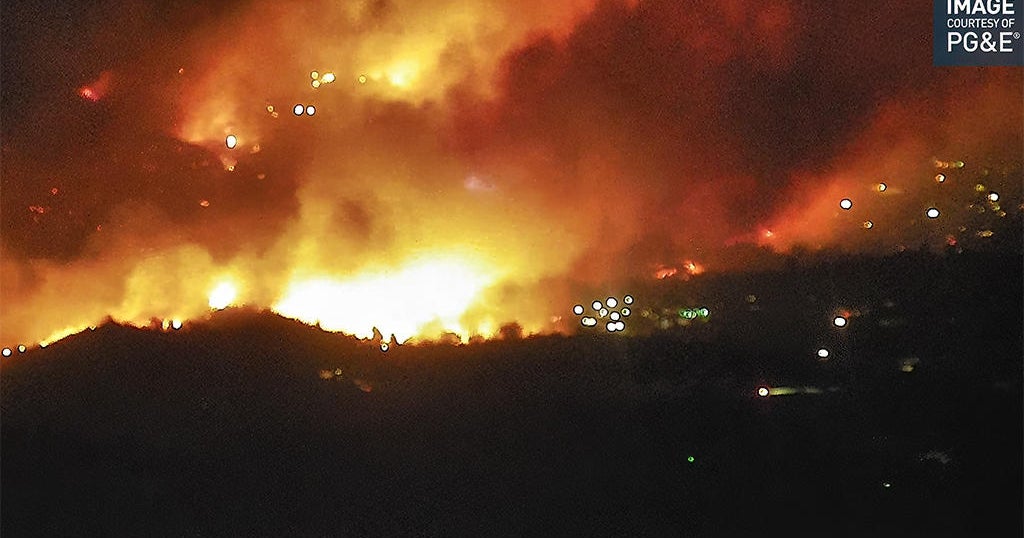Science
America’s Fire Spotters Aren’t Ready to Fade Away Just Yet

If, on a hot, dry day a fire should break out within a certain 300,000-acre patch of northwest Montana, in an expanse of backcountry between the crest of the Whitefish Range and the glacier-carved peaks that hug the Continental Divide, there’s a good chance Leif Haugen will be the first person on Earth to see it.
For the better part of an hour, he might be the only person.
Mr. Haugen has worked for more than half of his 52 years as a fire lookout, scanning the larch and pine wilderness from a one-room mountaintop cabin. Alone most of the time but for his thoughts, his mutt, Ollie, and the occasional crackle of voices on the radio, he is part of a nationwide band of professional watchers who, like lighthouse keepers, stand on solitary guard between civilization and nature’s uncaring whims.
More and more, he stands at another divide, too: between human jobs and automation. As land managers seek new tools to deal with the threat of catastrophic wildfires, which is rising in the West as the planet warms and Americans build more homes near overgrown forests and other vulnerable places, the days of lookouts might be numbered.
The chief of the U.S. Forest Service, Randy Moore, told lawmakers in March that the agency was moving away from humans in watchtowers. The future of fire detection, he said, is cameras. “We need to lean much further into the technology arena,” he said.
A spokesman, Scott Owen, declined to say whether the Forest Service had specific plans for shrinking its number of lookouts. Already, though, their ranks are down considerably from before World War II, when thousands of rangers were stationed across hilltops as frontline troopers in the young agency’s all-out war on fire.
Today the service staffs just 71 lookouts in Washington and Oregon; 59 in California; and 52 in Montana, northern Idaho and northwest Wyoming, Mr. Owen said. Nationwide, including lookouts run by other federal, state and local agencies, perhaps 300 are in service, according to Gary Weber, treasurer of the Forest Fire Lookout Association, a preservation group. Of the others still standing, many are now vacation rentals.
And yet, as officials in northwest Montana will tell you, there are reasons the lookout isn’t ready to disappear into the history books. Not completely. Not yet.
For Mr. Haugen’s job is not merely to locate fires, though he says he can do this in a wider range of conditions than helicopters (which can’t hover safely in thunderstorms), more precisely in some cases than planes (which can’t easily maneuver in narrow valleys) and more accurately at times than satellites (which can mistake sun-warmed rocks for fires).
He also relays messages between dispatchers and firefighters in canyons where the mountains block radio and cell signals. He tracks local weather shifts that affect the way fires behave and move. And he serves as safety watch for crews on the ground, alerting them to blazes that could churn their way and planning escape routes. Fifty percent of his job, he said, takes place once a fire response is underway.
“A human on top of a mountain can provide so much more than a piece of technology,” said Jeremy Harker, the fire management officer for Glacier National Park, a stretch of which Mr. Haugen surveys from his perch in the neighboring Flathead National Forest.
August’s deadly blaze on Maui notwithstanding, this fire season so far has been the nation’s most subdued in a decade. Wet weather has dampened risks across much of California, though not in its northernmost forests, where large fires have raged in recent weeks. Alaska had its calmest season on record until lightning ignited a slew of blazes in late July. Fires have destroyed homes and prompted evacuations in Washington and Oregon.
Wildfires unfold across vast, difficult terrain, in fast-changing conditions and with a frightening amount of random chance. In places like Glacier, officials don’t just put them all out. They must decide, sometimes hour by hour, whether letting a fire burn might provide ecological benefits or whether it is threatening enough lives and property to justify putting firefighters at risk.
New technology aids in these decisions, said Andy Huntsberger, a district fire management officer in the Flathead. But “it doesn’t replace the human element,” he said. Since 1998, the number of staffed lookouts in Glacier and the Flathead has grown to 12 from five.
Nobody doubts that cameras are getting better at the basic mechanical task of spotting smoke. California has a network of more than 1,000 fire-monitoring cameras and sensor arrays, and it is augmenting them with artificial intelligence.
The Douglas Forest Protective Association, which handles firefighting on 1.6 million acres of private and government land in southwest Oregon, has replaced its eight staffed lookouts with a camera system developed by FireWeb, a company in South Africa. The agency now employs six people to monitor the feeds from 36 cameras between 8 a.m. and 9 p.m. daily during fire season.
Scientists are getting better at monitoring wildfires from space, too, though satellites still have big limitations.
The main fire-observing orbiters used by NASA and the Forest Service get a look at the same location in the contiguous United States only a few times a day, and not always at a great angle. So even after a blaze is large enough to be detected, it might be three to 12 hours before a satellite sees it and the data is processed, said Louis Giglio, a professor of geographical sciences at the University of Maryland who works with NASA on satellite fire monitoring.
Weather satellites that sit above the same region of Earth can locate hot spots more speedily, but they can’t always distinguish a small blaze from, say, a hot rock. And they work better on open, brush-filled lands like Southern California’s than in dense forests like those in northwest Montana, where tree canopies can obscure a smoldering fire for days, said Ryan Leach, a meteorologist with the National Weather Service in Missoula, Mont.
Human lookouts, however, can see the smoke much sooner. “They can detect the fires quicker than the satellites and catch them when they’re smaller, less dangerous and easier to put out,” Mr. Leach said.
Canada, which has had a record-shattering wildfire season, is preparing to launch dedicated fire-monitoring satellites in 2029. Start-ups in Israel and Germany are building satellite-based early warning systems.
Yet spotting fires sooner might not be the biggest benefit of such projects, Dr. Giglio said. Instead, data from new orbiters could improve scientists’ models of how fires spread. This could help officials plan evacuations better, and help land managers conduct more thinning and intentional burning of dense forests. “I just feel like we’re neglecting the less-flashy stuff,” Dr. Giglio said.
Leif Haugen’s setup at Thoma Lookout is about as unflashy as it gets. The glaring exception (And how could it be otherwise?) is the view, a spellbinding panorama of the Crown of the Continent region.
His cabin, elevation 7,104 feet, or just under 2,200 meters, is off the grid and has no running water. There are windows on all sides, an alidade for measuring angles and well-thumbed copies of “Moby-Dick” and Cormac McCarthy’s “Border Trilogy.” Sometimes Mr. Haugen cooks burritos in a propane oven that, if it is on for more than a few minutes, makes the whole place smell like mouse urine.
“It takes a certain kind of person” to be a lookout, he said on a recent evening, sitting outside his cabin as the clouds dropped ghostly trails of virga over the valley. “A lot of people think, ‘Oh, I could do that.’ And they do it for a year and flame out.”
When did he realize he was the right kind of person? “My first season.”
Mr. Haugen grew up in suburban Minneapolis, and for someone who spends a lot of time on his own in the woods, he still has plenty of what he calls “Minnesota nice.” He generously shared his time, stories and coffee with a reporter and a photographer while also acknowledging, rather cheerfully, that he hoped no more visitors would show up once they left. (“No offense.”)
He spoke of the pride he took in supporting fire managers, firefighters and his fellow lookouts, whom he helps train in mapping, radio and safety skills. But he also relishes his job’s more selfish aspects: the solitude, the long walks on empty trails.
“You have an intimacy with the landscape that you acquire,” said Inez Love, 72, a retired teacher who volunteers as a lookout in the Flathead. Each summer, “I leave feeling like I’m leaving something dear.”
Mr. Haugen has worked as a lookout since 1994, but he is still a temporary, seasonal employee, with no benefits. He gets overtime, but not as much as firefighters. During the off-seasons, he works as a carpenter and homebuilder, earning four times as much per hour as he does as a lookout, and he puts those skills to use restoring old fire lookout posts.
It’s been two years since he built a house, though. City dwellers and remote workers flocked to Montana in the early days of the pandemic seeking big skies and open spaces, driving up home prices. Mr. Haugen was already feeling overworked, and the Covid boom gave him a good reason to quit.
Rising living costs are making it harder for the Forest Service to hire in the Flathead area, Mr. Huntsberger, the fire management officer, said. Five years ago, an opening for a firefighter or fire management job might receive 10 to 20 applicants, he said. Of late it’s more like two or three. Even one.
The combination is inauspicious, and it is appearing in other parts of the West as well: more houses in fire-prone places, not enough fire experts.
“The fire was here before us, and the fire will be here after us,” Mr. Huntsberger said. What’s new is all the development we have placed in fire’s way, and the need to protect it. “We want to do that,” he said. “But, you know, it creates challenges.”

Science
Live poultry markets may be source of bird flu virus in San Francisco wastewater

Federal officials suspect that live bird markets in San Francisco may be the source of bird flu virus in area wastewater samples.
Days after health monitors reported the discovery of suspected avian flu viral particles in wastewater treatment plants, federal officials announced that they were looking at poultry markets near the treatment facilities.
Last month, San Francisco Public Health Department officials reported that state investigators had detected H5N1 — the avian flu subtype making its way through U.S. cattle, domestic poultry and wild birds — in two chickens at a live market in May. They also noted they had discovered the virus in city wastewater samples collected during that period.
Two new “hits” of the virus were recorded from wastewater samples collected June 18 and June 26 by WastewaterSCAN, an infectious-disease monitoring network run by researchers at Stanford, Emory University and Verily, Alphabet Inc.’s life sciences organization.
Nirav Shah, principal deputy director of the U.S. Centers for Disease Control and Prevention, said that although the source of the virus in those samples has not been determined, live poultry markets were a potential culprit.
Hits of the virus were also discovered in wastewater samples from the Bay Area cities of Palo Alto and Richmond. It is unclear if those cities host live bird markets, stores where customers can take a live bird home or have it processed on-site for food.
Steve Lyle, a spokesman for the state’s Department of Food and Agriculture, said live bird markets undergo regular testing for avian influenza.
He said that aside from the May 9 detection in San Francisco, there have been no “other positives in Live Bird Markets throughout the state during this present outbreak of highly-pathogenic avian flu.”
San Francisco’s health department referred all questions to the state.
Even if the state or city had missed a few infected birds, John Korslund, a retired U.S. Department of Agriculture veterinarian epidemiologist, seemed incredulous that a few birds could cause a positive hit in the city’s wastewater.
“Unless you’ve got huge amounts of infected birds — in which case you ought to have some dead birds, too — it’d take a lot of bird poop” to become detectable in a city’s wastewater system, he said.
“But the question still remains: Has anyone done sequencing?” he said. “It makes me want to tear my hair out.”
He said genetic sequencing would help health officials determine the origin of viral particles — whether they came from dairy milk, or from wild birds. Some epidemiologists have voiced concerns about the spread of H5N1 among dairy cows, because the animals could act as a vessel in which bird and human viruses could interact.
However, Alexandria Boehm, professor of civil and environmental engineering at Stanford University and principal investigator and program director for WastewaterSCAN, said her organization is not yet “able to reliably sequence H5 influenza in wastewater. We are working on it, but the methods are not good enough for prime time yet.”
A review of businesses around San Francisco’s southeast wastewater treatment facility indicates a dairy processing plant as well as a warehouse store for a “member-supported community of people that feed raw or cooked fresh food diets to their pets.”
Science
Be grateful for what you have. It may help you live longer

Death may be inevitable, but that hasn’t stopped health researchers from looking for ways to put it off as long as possible. Their newest candidate is something that’s free, painless, doesn’t taste bad and won’t force you to break a sweat: Gratitude.
A new study of nearly 50,000 older women found that the stronger their feelings of gratitude, the lower their chances of dying over the next three years.
The results are sure to be appreciated by those who are naturally inclined toward giving thanks. Those who aren’t may be grateful to learn that with practice, they might be able to enhance their feelings of gratitude and reap the longevity benefits as well.
“It’s an exciting study,” said Joel Wong, a professor of counseling psychology at the University of Indiana who researches gratitude interventions and practices and wasn’t involved in the new work.
Mounting evidence has linked gratitude with a host of benefits for mental and physical health. People who score higher on measures of gratitude have been found to have better biomarkers for cardiovascular function, immune system inflammation and cholesterol. They are more likely to take their medications, get regular exercise, have healthy sleep habits and follow a balanced diet.
Gratitude is also associated with a lower risk of depression, better social support and having a greater purpose in life, all of which are linked with longevity.
However, this is the first time researchers have directly linked gratitude to a lower risk of earlier death, Wong and others said.
“It’s not surprising, but it’s always good to see empirical research supporting the idea that gratitude is not only good for your mental health but also for living a longer life,” Wong said.
Study leader Ying Chen, an empirical research scientist with the Human Flourishing Program at Harvard University, said she was amazed by the dearth of studies on gratitude and mortality. So she and her colleagues turned to data from the Nurses Health Study, which has been tracking the health and habits of thousands of American women since 1976.
In 2016, those efforts included a test to measure the nurses’ feelings of gratitude. The women were asked to use a seven-point scale to indicate the degree to which they agreed or disagreed with six statements, including “I have so much in life to be thankful for” and “If I had to list everything I felt grateful for, it would be a very long list.”
A total of 49,275 women responded, and the researchers divided them into three roughly equal groups based on their gratitude scores. Compared with the women with the lowest scores, those with the highest scores tended to be younger, more likely to have a spouse or partner, more involved in social and religious groups, and in generally better health, among other differences.
The average age of nurses who answered the gratitude questions was 79, and by the end of 2019, 4,068 of them had died. After accounting for a variety of factors such as the median household income in their census tract, their retirement status, and their involvement in a religious community, Chen and her colleagues found that the nurses with the most gratitude were 29% less likely to have died than the nurses with the least gratitude.
Then they dug deeper by controlling for a range of health issues, including a history of heart disease, stroke, cancer and diabetes. The risk of death for the most grateful women was still 27% lower than for their least grateful counterparts.
When the researchers considered the effects of smoking, drinking, exercise, body mass index and diet quality, the risk of death for the nurses with the most gratitude remained lower, by 21%.
Finally, Chen and her colleagues added in measures of cognitive function, mental health and psychological well-being. Even after accounting for those variables, the mortality risk was 9% lower for nurses with the highest gratitude scores.
The findings were published Wednesday in JAMA Psychiatry.
Although the study shows a clear link between gratitude and longevity, it doesn’t prove that one caused the other. While it’s plausible that gratitude helps people live longer, it’s also possible that being in good health inspires people to feel grateful, or that both are influenced by a third factor that wasn’t accounted for in the study data.
Sonja Lyubomirsky, an experimental social psychologist at UC Riverside who studies gratitude and was not involved in the study, said she suspects all three things are at work.
Another limitation is that all of the study participants were older women, and 97% of them were white. Whether the findings would extend to a more diverse population is unknown, Wong said, “but drawing on theory and research, I don’t see a reason why it wouldn’t.”
There can be downsides to gratitude, the Harvard team noted: If it’s tied to feelings of indebtedness, it can undermine one’s sense of autonomy or accentuate a hierarchical relationship. Lyubomirsky added that it can make people feel like they’re a burden to others, which is particularly dangerous for someone with depression who is feeling suicidal.
But in most cases, gratitude is an emotion worth cultivating, Lyubomirsky said. Clinical trials have shown that gratitude can be enhanced through simple interventions, such as keeping a gratitude journal or writing a thank-you letter and delivering it by hand.
“Gratitude is a skill that you can build,” she said.
And like diet and exercise, it appears to be a modifiable risk factor for better health.
Lyubomirsky has found that teenagers who were randomly assigned to compose letters of gratitude to their parents, teachers or coaches took it upon themselves to eat more fruits and vegetables and cut back on junk food and fast food — a behavior not shared by classmates in a control group. Perhaps after reflecting on the time, money and other resources invested in them, the teens were inspired to protect that investment, she said.
More research will be needed to see whether interventions like these can extend people’s lives, but Chen is optimistic.
“As the evidence accumulates, we’ll have a better understanding of how to effectively enhance gratitude and whether it can meaningfully improve people’s long-term health and well-being,” she said.
Science
Drug can amplify naloxone's effect and reduce opioid withdrawals, study shows

Naloxone has long been hailed as a life-saving drug in the face of the opioid epidemic. But its capacity to save someone from an overdose can be limited by the potency of the opioid — a person revived by naloxone can still overdose once it wears off.
Stanford researchers have found a companion drug that can enhance naloxone’s effect — and reduce withdrawal symptoms. Their research on mice, led by Stanford University postdoctoral scholar Evan O’Brien, was published today in Nature.
Typically, overdose deaths occur when opioids bind to the part of the brain that controls breathing, slowing it to a stop. Naloxone reverses overdoses by kicking opioids off pain receptors and allowing normal breathing to resume.
However, it is only able to occupy pain receptors for 30 to 90 minutes. For more potent opioids, such as fentanyl, that may not be long enough.
To determine how the naloxone companion drug, which researchers are calling compound 368, might boost naloxone’s effectiveness, researchers conducted an experiment on pain tolerance in mice, said Jay McLaughlin, a professor of pharmacology at the University of Florida. How quickly would mice pull their tails out of hot water, depending on which combination of opioids and treatments they were given?
Mice that were injected with only morphine did not respond to the hot water — given their dulled pain receptors. Mice given morphine and naloxone pulled their tails out within seconds. No surprises yet.
When the dosage of naloxone was reduced and compound 368 was added, the compound was found to amplify naloxone’s effects, as if a regular dose was used. When used on its own, the compound had no effect, indicating that it is only helpful in increasing the potency of naloxone.
What researchers did not expect, however, was that the compound reduced withdrawal symptoms.
McLaughlin said withdrawal is one reason that people who have become physically dependent on opioids may avoid naloxone.
“Opioid withdrawal will not kill you, but I have talked to a number of people who have gone through it, and they have all said the same thing: … ‘I wished I was dead,’” McLaughlin said. “It has a massive range of nasty, horrible effects.”
The idea that the compound could amplify naloxone’s effect at a lower dosage, while limiting withdrawal symptoms, indicates that it may be a “new therapeutic approach” to overdose response, McLaughlin said.
The research team said their next step is to tweak the compound and dosage so that the effects of naloxone last long enough to reverse overdoses of more potent drugs.
Though the compound is not yet ready for human trials, the researchers chose to release their findings in the hope that their peers can double check and improve upon their work, said Susruta Majumdar, another senior author and a professor of anesthesiology at the Washington University School of Medicine in St. Louis.
“We may not be able to get that drug into the clinic, but somebody else may,” Majumdar said. He added: “Let them win the race.”
-

 Politics1 week ago
Politics1 week agoPopular Republican and Trump running mate contender makes first Senate endorsement in 2024 races
-

 News1 week ago
News1 week agoToplines: June 2024 Times/Siena Poll of Registered Voters Nationwide
-

 Politics1 week ago
Politics1 week agoFox News Politics: Trump Ungagged…Kinda
-

 Politics1 week ago
Politics1 week agoObama again stepping into role as Joe's closer ahead of Trump v Biden rematch
-

 News1 week ago
News1 week agoIowa floodwaters breach levees as even more rain dumps onto parts of the Midwest
-

 News5 days ago
News5 days agoVideo: How Blast Waves Can Injure the Brain
-

 Politics1 week ago
Politics1 week agoThe many faces of Donald Trump from past presidential debates
-

 Politics1 week ago
Politics1 week agoMike Kennedy advances past crowded GOP primary to secure nomination for open Utah House seat















